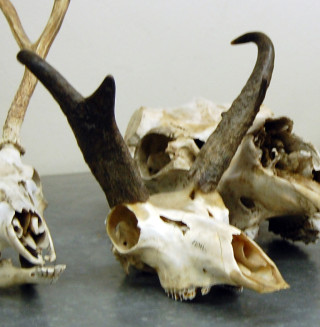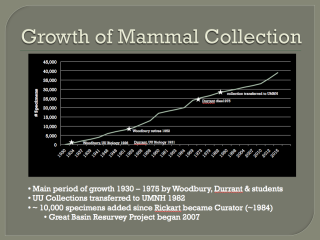Mammal Collections

With approximately 35,000 specimens, the Museum's mammal collection is one of the largest in western North America. The collection includes 40 holotypes of Utah mammals (the 12th largest number of types in North American collections). Nearly 300 species from 52 families and 13 orders are represented. Although the collection includes material from throughout the world, nearly 90% of the specimens are from Utah and surrounding states reflecting the work of Stephen Durrant and students on regional mammals. Important historical material includes several thousand specimens from the Bonneville Basin, as well as collections from Glen Canyon, Flaming Gorge, and other locations within the Colorado drainage that have since been inundated by reservoirs. In recent years, research by Eric Rickart (Curator), Rebecca Rowe (Research Associate), Shannen Robson (Collection Manager), and colleagues have added approx. 4,000 specimens of regional mammals to the collection and led the development of a frozen tissue collection of more than 3,000 samples used in studies of comparative genetics.
Primarily intended as research resources, the Museum's vertebrate collections support original work in fields as diverse as systematic zoology, functional morphology, molecular genetics, historical biogeography, community ecology, conservation biology, and zooarchaeology. Collection resources are utilized for instruction at all levels, including several upper division courses at the University of Utah, and graduate and faculty research in the departments of Biology, Anthropology, and Geography. The collections also provide reference material for a variety of artists and craftspeople.
Mammal Networked Information System (ManIS)-Database Portal for Mammal Specimen Records
Field Guide to Mammals of the Wasatch Front--more entries coming soon, check back periodically!
